Tattoos are part of our cultural heritage and during the last few decades, we have seen a renaissance of tattooing. In this last part, we look at tattoo removal, permanent make-up, and henna.
10. Removal of a Tattoo
Full of anticipation and a sense of euphoria, many people arrange to have the motif of their dreams applied as a tattoo. Nevertheless, it frequently happens that disillusionment sets in later, and (for any number of reasons), one’s tattoo is no longer pleasing. A poor job of tattooing, such that a shark looks more like a dolphin, or a rose more like a tulip, is also not infrequent. A classic case of a tattoo that later becomes undesirable would involve the name of a former partner. There are then three possibilities:
10.1. Overlaying/Modification
The first involves modifying the existing tattoo to develop a new motif. In this regard, a creative tattoo artist can achieve astonishing results. For example, when Johnny Depp, after separating from Winona Ryder, sought to pursue a path that was not all that original, he decided to alter the pledge of love “Winona forever” to read “Wino forever”.
10.2. Surgical Treatment
More drastic removal methods with deeper intrusion into the skin tissue, and the associated greater risk of complications, represent another possibility. Using a “dermabrasion technique,” the upper surface of the skin is surgically abraded [32], or the skin layer might even be completely removed (excised). These radical approaches are indeed effective, but elaborate and costly, and they are invoked only in extremely difficult cases, as with especially gnarled and elevated skin changes. These methods are no longer commonly used and do not lead to scar-free, smooth skin.
Removal of pigmented layers of skin can sometimes also be achieved by injection of lactic acid [33], although this method tends to be not very effective, and involves a risk of infection and scar formation.
10.3. Laser Treatment
A third treatment methodology is the application of pulsed lasers, i.e., quality-switched (QS) lasers [34] that direct powerful light impulses with a duration in the nano- to picosecond range upon the pigment-containing skin area. Using ruby, alexandrite, and Nd:YAG lasers (neodymium-doped yttrium-aluminum-garnet lasers) provides a selection of wavelengths that correspond to pigment absorption bands (see Fig. 15 and Tab.1).
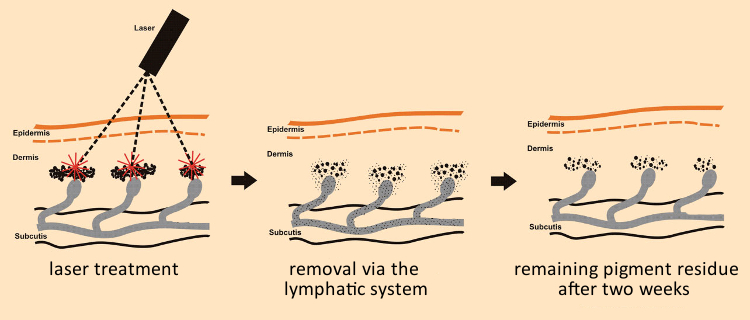 |
|
Figure 15. Tattoo removal by laser. |
|
Table 1. Lasers employed for tattoo removal. |
 |
Bombardment with a laser leads to very brief high-energy pulses that heat pigment particles for a very short period of time, but can heat them to above 1000 °C. The resulting hot particle surfaces cause water in surrounding tissue to boil explosively, and the expanding steam bubbles create a shockwave that smashes the pigment particle mechanically [35].
Blue and black pigments absorb visible light of all wavelengths. By contrast, lighter pigments (white, red, yellow), with narrow absorption bands, acquire less energy, since the laser wavelengths do not correspond precisely with absorption maxima. Laser impulses still cause microparticles to be shattered to some extent into nanoparticles, which can then be transported by macrophages to nearby lymph nodes.
Extreme sudden heating of a pigment particle leads not only to mechanical crushing but also to the breaking of chemical bonds within the dye molecules. Basically, one observes intensified reactions analogous to those promoted by irradiation with visible and UV light. For example, N=N double bonds in azo dyes are broken apart by radical and reductive mechanisms (see Fig. 16). Red Pigment 9 (6) (permissible for tattooing purposes) is irradiated in an acetonitrile suspension for 10 minutes with a QS Nd:YAG laser (pulse duration 8 ns, 532 nm, 15 mJ per pulse, repeat rate 10 Hz). The cleavage products are questionable from a health standpoint: o-dichlorobenzene (7) elicits tumors in the kidney (rats) and the liver (mice), 2,5-dichloroaniline (8) is toxic with respect to kidneys (rats), and the two naphthol-AS derivatives (9) and (10) are skin irritants [36,37].
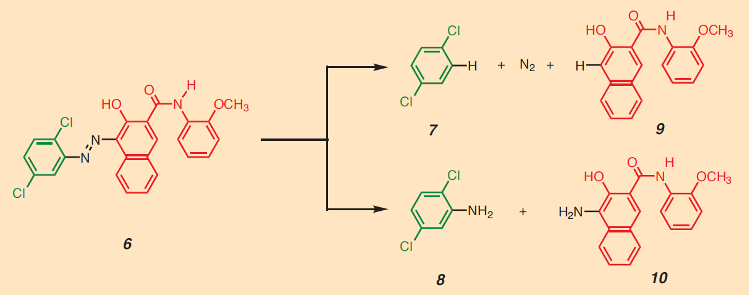 |
|
Figure 16. Radical and reductive cleavage of an azo pigment. |
10.3.1. Complications
Laser treatment is also not free of complications. These include pain, inflammatory or post-allergenic reactions, hypopigmentations, and scar formation, as well as color changes in residues from multicolored tattoos.
Recently, the German Federal Institute for Risk Evaluation (Bundesinstitut für Risikobewertung, BfR) released a surprising study of the laser-induced decay of copper phthalocyanine (1, see Fig. 17). The only blue pigment utilized in Europe is phthalocyanine blue (Blue 15, Pigment B15:3) [38]. It had long been regarded as chemically “indestructible”, and relatively stable to light [26]. The study showed, however, that copper phthalocyanine decays thermally, “already” at temperatures above 500 °C, and also under high-energy laser irradiation, giving benzodinitrile (11). This corresponds to the reverse of the substance’s synthesis [39]. Also of interest are certain further cleavage products: benzonitrile (12), benzene (13), and hydrogen cyanide (14).
 |
|
Figure 17. Laser-induced degradation of copper phthalocyanine. |
Given that cleavage products in both thermolysis and pyrolysis were identical, this suggests that success in a laser treatment is dependent above all on brief but powerful heating of the pigment particles. According to the authors of this experimental study, the HCN level at least locally reaches toxicologically relevant levels. Nevertheless, these pigment dispersion results – achieved under in vitro conditions – must still be confirmed under more realistic in vivo circumstances.
11. Legislative Challenges
Given that there are now 100 million tattooed Europeans, there has been an emphasis from all sides on an urgent need for legislation. At the European level, the Council of Europe has so far suggested only a non-binding resolution (see Tab. 2) [23], from which in Germany a binding Tattooing Agent Ordinance [24] followed. The latter includes a list (“negative list”) of roughly 36 individual pigments, along with para-phenylamine diamine, that are now banned. Moreover, all azo pigments that, by reductive cleavage, can release any of around 40 listed anilines, are forbidden as well.
|
Table 2. Legislative regulations regarding various product classes. |
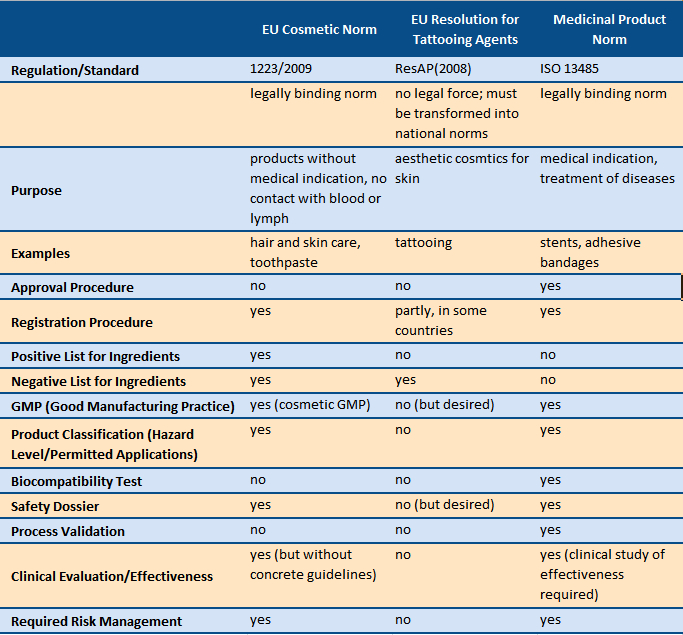 |
By means of a link to the EU Cosmetic Regulations, a connection is also made to a formulary of coloring agents that are permitted in cosmetic products. This formulary (“positive list”) in turn automatically rules out all coloring agents that are not listed.The “positive” formulary includes a few pigments whose use entails certain limitations. Thus, with respect to cosmetic products, the application of certain pigments is explicitly forbidden if they might come in contact with mucous membranes or the eyes. This ban also extends to the tattooing-agent ordinance. The logical linkage between the two sets of standards results, in a few cases, in unfortunate absurdities (see Fig. 18).
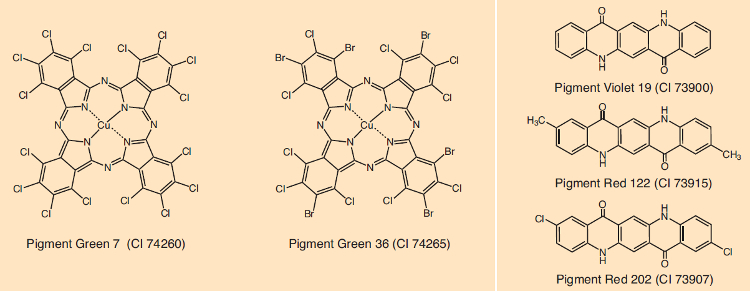 |
|
Figure 18. Legislative inconsistencies [26]. |
Pigment Green 7 (CI 74260) is, according to the cosmetics regulation, in fact permitted in cosmetic products, with the exception of eye cosmetics (Annex IV, 107 [25]). Due to this one limitation, the green pigment is automatically excluded from tattoo dyes due to the Tattooing Agent Ordinance. Green 7 was previously the most popular green pigment in this application.
The structurally very similar Pigment Green 36 (Cl 74265) is not present in the “positive” formulary for cosmetics products and is thus automatically excluded from cosmetic products. That is to say, since it is absolutely not listed, no specific limitations can exist for it with respect to cosmetic use. But this green pigment is not explicitly forbidden in the tattooing-agent regulations, so it must be permitted for tattooing. Due to this inconsistency, for tattooing purposes Pigment Green 7 has been completely displaced by Pigment Green 36 – a development imposed legislatively that makes little sense from a chemical point of view.
11.2. Example 2
A second example involves the pigments CL 73900 and Cl 73915, which in the cosmetics regulations are permitted only when washed off after use. Because of this limitation, both pigments are automatically forbidden according to the tattooing-agent regulations. Pigment CL 73907 is not mentioned in the cosmetics regulation, so it is not on the tattooing agent “forbidden list”, and is thus permissible as a tattooing pigment [26].
These inconsistencies can be attributed to hastily conceived legislation, but of greater concern is the fact that although the German tattooing-agent regulation for polycyclic aromatic hydrocarbons, primary aromatic amines, and heavy metals was adopted from the EU resolution, no binding methods were prescribed for how limits were to be monitored. Moreover, there are no scientifically validated safety studies associated with these limits.
The German Federal Institute for Risk Evaluation has developed extensive recommendations [40] which are supposed to lead to EU regulations. A central requirement is that one start from a negative list with forbidden ingredients, but this can easily be circumvented by minor structural modifications. What is called for instead is a positive list of permitted pigments, where everything else would automatically be prohibited [26]. Since, for covering the entire color palette, carbon black, titanium dioxide and roughly two dozen basic colored pigments would actually suffice, it should be possible to develop such a positive list.
12. Permanent Make-Up (PMU)
Permanent make-up refers on one hand to the purely cosmetic embellishment of limited areas of skin, e.g. eyebrows, eyelids, or lip contours (see Fig. 19). Alternatively, permanent make-up can be used to mask scars (e.g., due to burns, or surgical closure of a cleft palate) or loss of some particular body feature, as for example, in the optical reconstruction of the circular brown pigmentation that ordinarily surrounds a nipple after breast removal surgery.
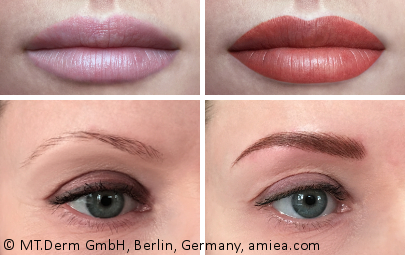 |
|
Figure 19. Permanent make-up on lips and eyebrows. top: Lips before and after pigmentation; bottom: eyebrow region before and after pigmentation (Photos © MT.Derm GmbH, Berlin, Germany, amiea.com). |
Basically, the introduction of permanent make-up entails equipment analogous to that used for tattooing. The apparatus pricks with a shorter stroke, however, so that the pigment will remain in the outer portion of the dermis. The applicable tattooing technique demands a pigment of higher viscosity, which also ensures when operating near the eyes or the mouth that no color can flow away.
Since with PMUs, smaller amounts of pigment are introduced into the skin and, in most cases, these pigments are constantly subject to exposure to light, the make-up will gradually fade, and will typically need to be renewed after three to five years. From a color standpoint, the pigments used tend to be less intense and varied, resembling natural hues of the respective parts of the body.
13. Henna
Applying henna make-up is not a matter of tattooing, but rather adding a temporary cosmetic coloring to the skin. The leaves of the henna bush (Lawsonia inermis) contain the characteristic pigment lawsone (15), the basis of henna extract, as 0.5 – 1.5% of their dry matter (see Fig. 20).
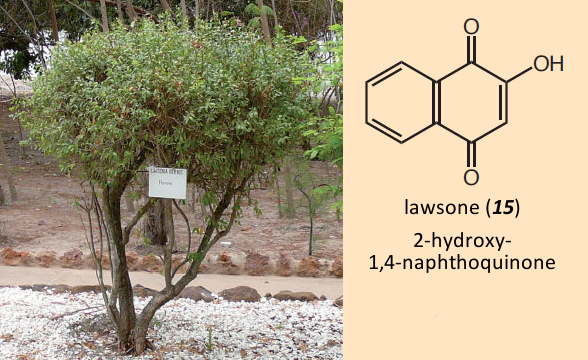 |
|
Figure 20. The henna shrub (Lawsonia inermis, image source: wikimedia commons, Atamari, CC BY-SA 3.0) and its pigment, lawsone. |
The dried leaves are ground up, mixed with water to give a paste, and then applied to the skin. The required exposure time is typically several hours. The eventual hue, ranging from bright orange to a dark mahogany-red, matures only after one or two days. In Western industrial nations, henna is utilized largely as a hair dye, but in India and the Islamic world, it is used as a skin coloring for the hands and feet.
The toxicological evaluation of Lawsonia inermis was the subject of heated public discussion among professionals, as well as in the press, some 15 years ago because various national and international expert commissions disagreed on the issue [41]. An initial fear of genetic harm from the material has in the meantime been allayed, and as early as 2003, the German Federal Institute for Risk Assessment established that neither henna as a whole nor lawsone as a component presents a genetic risk [42,43]. Nevertheless, it should be pointed out that lawsone still does not appear on the positives list of the European cosmetic regulations, and thus remains technically forbidden as a skin coloration agent.
13.1. Para-Phenylenediamine Does Not Belong in a Henna Mixture!
Recent years have seen an increasing number of reports of sometimes serious and persistent pathological changes (eczema, inflammations, hypopigmentation) following henna treatment (see Fig. 21) [44]. The culprit was soon identified: many henna mixtures were found to contain para-phenylenediamine (PPD) as an additive, a strongly sensitizing contact allergen, which with certain restrictions is nevertheless permitted in hair-dye products. The addition of PPD to henna pastes increases the color intensity, which can extend toward black, and causes the full color tone to develop more rapidly. No longer is it necessary that the pigment remain on the skin for several hours being washed off.
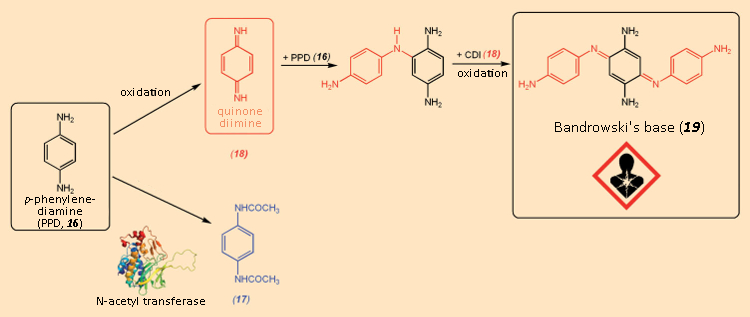 |
|
Figure 21. The role almost certainly played by para-phenylenediamine (PPD) in henna dyeing. Henna dyes supplemented with PPD often have an oxidizing agent added as well to deepen the color. This leads to formation of quinone diimine (18), which with excess PPD (26) condenses oxidatively to produce the carcinogen Bandrowski’s base (19). |
One should, however, observe the highest level of caution if, during a vacation, a henna treatment is found to produce a black effect after only an hour or so. Henna should never result in a black color. In such cases, one must assume that the color-paste contained the allergenic PPD [45]. PPD is such a nasty allergen that in 2006 it was declared “allergen of the year” by the American Society for Contact Dermatitis. A patient who has once been powerfully sensitized to PPD is likely to react lifelong to the compound, which may be present in small amounts in numerous everyday materials, like leather, rubber, textiles, or plastics.
The chemical basis for PPD’s allergenic action remains unknown. It does not react with proteins [46], and after introduction into the epidermis reacts quantitatively at its amino groups – upon catalysis with arylamine-N-acetyltransferase 1, with which amino groups generally are acetylated – and is then metabolized via the kidneys, and eliminated [47] (see Fig. 22). Oxidation products or metabolites of PPD must, therefore, be responsible for the allergic reaction. One of the candidates, known due to its discoverer as Bandrowski’s base [48,49], forms from quinone diimine, an oxidation product of PPD. Bandrowski’s base is genotoxic and has an extremely high sensitizing (i.e., allergenic) potential [50,51].
14. Think Before You Ink!
The decision to be tattooed is never an entirely rational one, but involves an emotional component instead. Before taking this step, the scientifically-oriented person should at least consider it reflectively, given that the editors of a current publication speak of it as the “greatest active experiment in human history regarding the introduction of particles into human skin” [26].
It is alarming that this mega-experiment is neither being logged nor reviewed, and it is being carried out outside every legal framework. In comparison to the scientific and regulatory efforts – including costly preclinical animal studies – associated with the approval of a pharmaceutically active ingredient, this disparity is inexplicable. It seems dubious that essential procedures according to the animal welfare act (e.g., for health evaluations of pigments with respect to anesthetized pigs!) are instead prohibited in the present case with respect to human subjects! Animal rights activists point out that an unnecessary procedure, tattooing, serving only for (subjective) adornment, doesn’t require even animal studies. Truly a sore point!
This freedom may seem attractive to some reckless people, but it should warrant considering the risk in advance. One thing is clear: Introducing dye particles irreversibly into deep layers of the skin, for a lifetime, amounts to undergoing a significant and wide-ranging laceration that brings risks with it. Risks of this magnitude should certainly be minimized.
There is one more thing to think about: scarcely a country on earth offers recognized professional training in the field of tattooing. Anyone can open a studio anywhere and start at once to apply tattoos. So take a good look around any tattoo parlor you are thinking about patronizing. The Swiss Federal Health Office offers the following well-intentioned tips [52]:
- Speak with a dermatologist before any procedure. Clear up whether you specifically are subject to any unusual risk for allergies.
- Ask around in your circle of acquaintances about others’ experiences with tattoo parlors or tattoo practitioners.
- Remember that tattoo artists and piercers are expected to practice due diligence and to respect accepted hygienic and procedural standards.
- Ask for evidence prior to piercing that all procedures will be conducted hygienically (disinfecting of skin and apparatus, sterile needles). If the parlor and the tattoo artist make an unkempt impression [53], leave at once!
- A responsible tattoo parlor advises the customer about post-procedural care.
Acknowledgements
We wish to thank Marcel Tritsch, Berlin, Germany, for a candid and enlightening interview, and Bianca Kremser, Berlin, for her insight into her personal attitude. Our thanks as well to Dr. S. Streller, Free University Berlin, for the critical review of the manuscript and her creative content suggestions, and Dr. P. Winchester, Free University Berlin, for her linguistic support. Dr. U. Hauri, Basel, Switzerland, und Dr. C. Walther, Oberschleißheim, Germany, helped us significantly with their numerous and encouraging comments.
References
[32] T. Bartscher, R. E. Horch, www.plastische-chirurgie.uk-erlangen.de, 2006.
[33] German Federal Institute for Risk Assessment, Tattoo-Entfernung: Einsatz wässriger Milchsäure ist mit gesundheitlichen Risiken verbunden (in German), bfr.bund.de, 2011.
[34] S. Irkoren, C. Demirdover, B. Z. Akad, M. Gorgu, The Q-Switched Nd:YAG Laser in Tattoo Removal and the
Effect of Lymphatic Elimination: An Experimental Study in Rabbits, Surgic. Sci. 2011, 2, 262. https://doi.org/10.4236/ss.2011.25058
[35] C. Bonnet, Enlever les tatouages au laser (Tattoo removal), youtube.com, 2011.
[36] R. Vasold et al., Tattoo Pigments are Cleaved by Laser Light – The Chemical Analysis In Vitro Provide Evidence for Hazardous Compounds, Photochem. Photobiol. 2004, 80, 185. https://doi.org/10.1111/j.1751-1097.2004.tb00069.x
[37] E. Engel et al., Tätowierungspigmente im Fokus der Forschung, Nachr. Chem. 2007, 55, 847. https://doi.org/10.1002/nadc.200751916
[38] I. Schreiver et al., Formation of highly toxic hydrogen cyanide upon ruby laser irradiation of the tattoo pigment phthalocyanine blue, Sci. Rep. 2015, 5, 12915. https://doi.org/10.1038/srep12915;
[39] Laboratory synthesis of 1 from benzodinitrile (11) (in German), ioc-praktikum.de.
[40] German Federal Institute for Risk Assessment, Anforderungen an Tätowiermittel (in German), bfr.bund.de, 2012.
[41] T. Platzek et al., Farben in der Kosmetik: Toxikologie und Regulation (in German), Bundesgesundhbl. Gesundheitsforsch. Gesundheitsschutz 2005, 48, 76. https://doi.org/10.1007/s00103-004-0944-y
[42] German Federal Institute for Risk Assessment, Gesundheitliche Bewertung der Substanz “Lawson” (in German), bfr.bund.de, 2003.
[43] D. Kirkland and D. Marzin, An assessment of the genotoxicity of 2-hydroxy-1,4-naphthoquinone, the natural dye ingredient of Henna, Mutation Res. 2003, 537, 183. https://doi.org/10.1016/S1383-5718(03)00077-9
[44] B. M. Hausen et al., Henna/p-Phenylendiamin-Kontaktallergie: Folgenschwere Dermatosen nach Henna-Tätowierungen (in German), Dtsch. Arztebl. 2001, 98, A 1822.
[45] K. Riewerts, Von Haarfärbemitteln und Hautausschlägen: Kosmetische Mittel und Verbraucherschutz (in German), Chem. unserer Zeit 2006, 40, 378. http://doi.org/10.1002/ciuz.200600357
[46] J. M. L. White et al., p-Phenylenediamine allergy: the role of Bandrowski’s base, Clin. Exp. Allergy 2006, 36, 1289. https://doi.org/10.1111/j.1365-2222.2006.02561.x
[47] G. J. Nohynek et al., Under the skin: Biotransformation of para-aminophenol and para-phenylenediamine in reconstructed human epidermis and human hepatocytes, Toxicol. Lett. 2005, 158, 196. https://doi.org/10.1016/j.toxlet.2005.03.014
[48] E. Bandrowski, Ueber die Oxydation des Paraphenylendiamins (in German), Ber. Dtsch. Chem. Ges. 1894 , 27, 480. https://doi.org/10.1002/cber.18940270194
[49] W. M. Lauer, C. J. Sunde, The Structure and Mechanism of Formation of the Bandrowski Base, J. Org. Chem. 1938, 3, 261. https://doi.org/10.1021/jo01220a008
[50] B. N. Ames et al., Hair dyes are mutagenic: identification of a variety of mutagenic ingredients, Proc. Nat. Acad. Sci. USA 1975, 72, 2423.
[51] German Federal Institute for Risk Assessment, Henna-Haarfärbemittel mit p-Phenylendiamin (PPD) stellen ein Gesundheitsrisiko dar (in German), bfr.bund.de, 2011.
[52] Swiss Federal Office for Health, Merkblatt: Tattoos und Piercing: Hautschmuck, der unter die Haut geht (in German), news.uzh.ch, 2009.
[53] A macabre trip through the world of failed tattoos: https://www.youtube.com/watch?v=jtmJ6FvQVI0.
The Authors
 Henrik Petersen
Henrik Petersen
Henrik Petersen studied chemical engineering at the Magdeburg-Stendal University of Applied Sciences in Germany, earning his doctorate in polymer/colloid chemistry at the Fraunhofer Institute for Applied Polymer Research (IAP) in Potsdam, Germany. He has worked since 2012 in tattooing agent product development for MT.Derm GmbH in Berlin, where, since 2013, he has lead the R&D Chemicals division.
 Klaus Roth
Klaus Roth
Professor Klaus Roth of the Free University of Berlin, Germany, is the permanent author of the Focus Section of ChemViews Magazine.
The article has been published in German as:
- To Tattoo or not to Tattoo,
Henrik Petersen, Klaus Roth,
Chem. unserer Zeit 2016, 50, 44–66.
DOI: 10.1002/ciuz.201500740
and was translated by W. E. Russey.
To Tattoo or Not to Tattoo? – Part 1
Tattooing from a chemical point of view
To Tattoo or Not to Tattoo? – Part 2
Coloring materials employed in tattooing
To Tattoo or Not to Tattoo? – Part 3
The process of tattooing
To Tattoo or Not to Tattoo? – Part 4
Tattoo removal, permanent make-up, and henna
See all articles by Klaus Roth published in ChemistryViews Magazine


